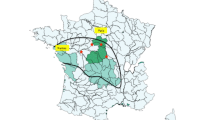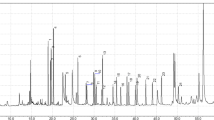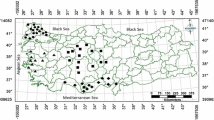Abstract
Organochlorine residues were measured in the carcasses and, in some cases, brains and stomach contents of four species of birds collected along the Sheboygan River, Wisconsin during the years 1976 to 1980. Polychlorinated biphenyls (PCBs) were high in all samples and were the contaminants of greatest concern. Carcass residues ranged from 23 to 218 ppm PCBs on a wet weight basis; these are levels associated with reproductive impairment in laboratory studies with some birds. Food items in the stomachs of collected birds contained from 12 to 58 ppm PCBs, indicating a heavy contamination of food sources. The brain of one bird contained 220 ppm PCBs, a level that is not in the lethal range but is very high. Birds feeding in the contaminated portions of the Sheboygan River may have been harmed by high PCB levels.
Similar content being viewed by others
References
Aulerich, R. J. and Ringer, R. K.: 1977, ‘Current Status of PCB Toxicity to Mink, and Effect on Their Reproduction’, Arch. Environ. Contam. Toxicol. 6, 279–292.
Briggs, D. M. and Harris, J. R.: 1973, ‘Polychlorinated Biphenyls Influence on Hatchability’, Poult. Sci. 52, 1291–1294.
Call, D. J., Greichus, Y. A., and Worman, J. J.: 1973, ‘Changes in a Polychlorinated Biphenyl (Aroclor 1260) Standard within the Bodies of Japanese Quail’, Proc. S. D. Acad. Sci. 52, 266–267.
Cecil, H. C., Bitman, J., Lillie, R. J., Fries, G. F., and Verrett, J.: 1974, ‘Embryotoxic and Teratogenic Effects in Unhatched Fertile Eggs from Hens Fed Polychlorinated Biphenyls (PCBs)’, Bull. Environ. Contam. Toxicol. 11, 489–495.
Clark, D. R. Jr.: 1981, ‘Bats and Environmental Contaminants: A Review’, Special Scientific Report-Wildlife No. 235, U.S. Fish and Wildlife Service, Washington, D.C., 27 pp.
Cromartie, E., Reichel, W. L., Locke, L. N., Belisle, A. A., Kaiser, T. E., Lamont, T. G., Mulhern, B. M., Prouty, R. M., and Swineford, D. M.: 1975, ‘Residues of Organochlorine Pesticides and Polychlorinated Biphenyls and Autopsy Data for Bald Eagles, 1971–72’, Pestic. Monit. J. 9, 11–14.
Dahlgren, R. B. and Linder, R. L.: 1971, ‘Effects of Polychlorinated Biphenyls on Pheasant Reproduction, Behavior, and Survival’, J. Wildl. Manage. 35, 315–319.
Dahlgren, R. B., Bury, R. J., Linder, R. L., and Reidinger, R. F. Jr.: 1972, ‘Residue Levels and Histopathology in Pheasants Given Polychlorinated Biphenyls’, J. Wildl. Manage. 36, 524–533.
Heinz, G. H., Hill, E. F., and Contrera, J. F.: 1980, ‘Dopamine and Norepinephrine Depletion in Ring Doves Fed DDE, Dieldrin, and Aroclor 1254’, Toxicol. Appl. Pharmacol. 53, 75–82.
Heinz, G. H. and Johnson, R. W.: 1981, ‘Diagnostic Brain Residues of Dieldrin: Some New Insights’, in D. W. Lamb and E. E. Kenaga (eds.), Avian and Mammalian Wildlife Toxicology: Second Conference, ASTM STP 757, American Society for Testing and Materials, Philadelphia, 72–92.
Karlsson, B., Persson, B., Sodergren, A., and Ulfstrand, S.: 1974, ‘Locomotory and Dehydrogenase Activities of Redstarts Phoenicurus phoenicurus L (Aves) given PCB and DDT’, Environ. Pollut. 7, 53–63.
Kleinert, S. J., Sheffy, T. B., Addis, J., Bode, J., Shultz, P., Delfino, J. J., and Lueschow, L.: 1978, ‘Final Report on the Investigation of PCBs in the Sheboygan River System’, Wisconsin Department of Natural Resources Technical Report, July 12, 1978, 51 pp.
Kreitzer, J. F. and Heinz, G. H.: 1974, ‘The Effect of Sublethal Dosages of Five Pesticides and a Polychlorinated Biphenyl on the Avoidance Response of Coturnix Quail Chicks’, Environ, Pollut. 6, 21–29.
Lillie, R. J., Cecil, H. C., Bitman, J., and Fries, G. F.: 1974, ‘Differences in Response of Caged White Leghorn Layers to Various Polychlorinated Biphenyls (PCBs) in the Diet’, Poult. Sci. 53, 726–732.
Peakall, D. B. and Peakall, M. L.: 1973, ‘Effect of a Polychlorinated Biphenyl on the Reproduction of Artificially and Naturally Incubated Dove Eggs’, J. Appl. Ecol. 10, 863–868.
Platonow, N. S. and Reinhart, B. S.: 1973, ‘The Effects of Polychlorinated Biphenyls (Aroclor 1254) on Chicken Egg Production, Fertility and Hatchability’, Can. J. Compar. Med. 37, 341–346.
Sileo, L., Karstad, L., Frank, R., Holdrinet, M. V. H., Addison, E., and Braun, H. E.: 1977, ‘Organochlorine Poisoning of Ring-Billed Gulls in Southern Ontario’, J. Wildl. Dis. 13, 313–322.
Stickel, W. H.: 1975, ‘Some Effects of Pollutants in Terrestrial Ecosystems’, in A. D. McIntyre and C. F. Mills (eds.), Ecological Toxicology Research, Plenum Publishing Corp., New York, 25–74.
Ulfstrand, S., Sodergren, A., and Rabol, J.: 1971, ‘Effect of PCB on Nocturnal Activity in Cages Robins, Erithacus rubecula L.’, Nature 231, 467–468.
Author information
Authors and Affiliations
Rights and permissions
About this article
Cite this article
Heinz, G.H., Swineford, D.M. & Katsma, D.E. High PCB residues in birds from the Sheboygan River, Wisconsin. Environ Monit Assess 4, 155–161 (1984). https://doi.org/10.1007/BF00398784
Issue Date:
DOI: https://doi.org/10.1007/BF00398784




